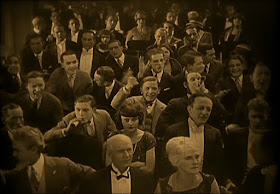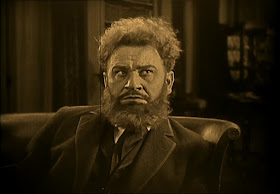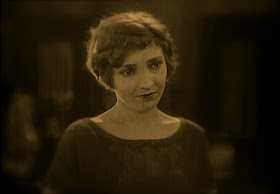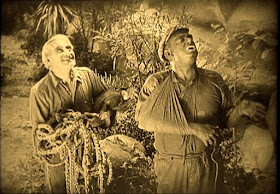Dunkirk and superpowered Amazons aside, 2017 has not been a vintage year for blockbusters but in 1925 it was a little different with The Big Parade being a huge $20 million hit followed by the likes of Ben Hur, The Gold Rush and The Phantom of the Opera. Also comfortably in the top ten grossers was The Lost World a science fantasy from the pen of Arthur Conan Doyle who swapped Baker Street for brontosaurus in his wildly successful book of the same name
We’re not so different 1925 and 2017, are we? Literary
adaptions fuelling Hollywood invention and excess only in this case they
knocked the ball right out of the Jurassic Park using techniques rarely seen
before and on a scale that was to set the template for the next century of
alien worlds from Kong all the way to Skull Island.
 |
| Sir Arthur abides... a snip from a contemporary documatary replaces his original intro. |
For Harry and Mabel, Frank, Lil, Jenny Wren, William,
Jessie and Jim, this would have been their first exposure to prehistoric
animation a visual shock on a par with any technological leap seen since
although I can’t see our Jessie being that impressed with such frippery.
Directed by Harry O. Hoyt and completely unlike anything
he or anyone else had produced before, this was adventure cinema as adventure
based on a concept that was far more believable in an age before satellites
took some of the fun out of exploration. As recently as twenty years ago an
expedition to a huge meteor crater in Africa was touted as possibly revealing a
“lost world” of new and previously-extinct species… we live in hope and we want
to believe.
But here the brave band of explorers discovers the past
alive; mind-blowing wish fulfilment we cinemutophiles can completely relate to. And here in the restored stucco walls of our
oldest music hall, we feel the same frisson as, with Emily O’Hara’s intrepid troop
of musical adventurers to guide us, we simply connect with a lost world of nitrate wonderment.
 |
| The indigenous sounds of the deep Amazonian rain forest. |
The Lucky Dog players snuck on stage in character, pith helmets
and jodhpurs along with an inflatable tyrannosaurus. Their music is witty and
very tightly orchestrated with Emily on guitar, mandolin, cello and musical
direction, Christopher Eldred on piano and clarinet, Daniel Tiberius Mays
(parents, Star Trek fans?!) on woodwind – a deliciously poignant flute and Nicholas
D. Ball on percussion and some very effective dino-sounds!
I loved their playful syncopations and when they were
clicked off by Nick’s drums their ensemble playing is a real joy – is dancing
allowed mid-film?! They also handled the thematic work well and I was
especially entranced by Emily’s Spanish guitar lines and Mr Eldred’s way with
the pianoforte: the bedrock of a score which not only included snatches of
contemporary songs – the lovely What’ll I
do? – but also a few notes from Jurassic Park (or was that just my
projection?!). It’s music that competes
sometimes with the narrative but for this film and in this setting, that’s
exactly what you need.
 |
| Hipsters go mad for silent film! |
Wiltons is an interesting silent film gig and it was good
to see so many young and unfamiliar faces and an audience who, inspired by the
Lucky Dog verve, had a ball with the film: laughter is the gateway response to silents.
Not that The Lost World is ever meant
to be taken entirely seriously; as with its modern counterparts, there’s a rich
mix of humour and action from the relationship between the squabbling
professors to the convenient get-out for our main hero at the end: what
happened in the jungle doesn’t always need to stay in the jungle!
 |
| The Trachodon about to do battle with the Allosaurus! |
We shouldn’t underestimate the impact stop motion
techniques had on contemporary audiences, just as the CGI from the first
Jurassic Park looks slightly awkward compared with Jurassic World over twenty years
later, technology moves on and our perceptions follow. The film’s special
effects maestro, Willis O’Brien had worked on stop-animation since 1918 and a
short test film he made was shown by Conan Doyle a meeting of the Society of
American Magicians, which included Harry Houdini in 1922. Doyle refused to
discuss the film's origins but the audience and press alike were astonished… the
New York Times declaring that if they were fakes they were “masterpieces”.
Sir Arthur is featured on his porch at the start of the
film, he looks happy enough and I’m sure a good deal was arranged for the
script as developed by Marion Fairfax. The author later declared that it was Lost
World’s Professor Challenger who was his favourite character and not the Great
Detective.
 |
| Wallace Beardy! |
You can understand as Challenger is all for pure
adventure even if here he’s opposed by the scientific establishment. He’s
played by Wallace Beery complete with wildling beard and scatty fringe highlighting wide
staring eyes as he’s laughed at by his peers. He’s looking for men to accompany
him on an expedition to the Amazon to try and rescue Maple White whose journal
suggests that dinosaurs still roam a plateau deep in the jungle. Noted
adventurer and game hunter Sir John Roxton (Lewis Stone) offers to join him as
does Professor Summerlee (Arthur Hoyt) who wants to prove him a fraud.
A young reporter, Edward Malone (Lloyd Hughes) also
offers to join up much to Challenger’s disgust – he hates fake news – but Ed
has a girl to impress with daring deeds, Gladys Hungerford (Alma Bennett). But,
once then young fellow spies White’s daughter Paula (Bessie Love) we and he
aren’t so sure of this prior commitment.
 |
| A US map of the Atlantic: Britain known by its proper name of Liverpool... |
Cut to animation of ship skipping down a map from London to
Brazil and the team are soon looking at a huge plateau with only one way up.
They climb a rock tower and walk across a tree trunk to the plateau but their
route is soon swiped away by the first of many huge new animals: the dinosaurs
are here!
The stop motion is still impressive (thousands of movements over hundreds of painstaking days) and O’Brien worked a
split screen with increasing confidence as he showed the “tiny” actors against
a backdrop of dense forest and battles between Allosaurus, Brontosaurus, Triceratops
and Stegosaurus (the last two my childhood favourite dinos). By the film’s
spectacular conclusion, we see a Brontosaurus let lose in 1925 London… eight
years later, O’Brien had a giant gorilla doing the same in New York.
 |
| Very smart split screens |
If the story intensity drops on the plateau it’s because
the adventure was all in seeing these great creatures live and move again and
we’re all so used to seeing dinosaurs now. But there were moments when music
and music hall helped us recapture the magic of discovery once again.
 |
| Reaction shots are key to believability. |
It’s a classic bit of fun – pure cinematic pleasure! Wilton’s
and the Lucky Dogs made sure we all had the best of it!
This was part of a short summer season from Lucky Dog at
Wiltons including the magnificent Brit-com Shooting
Stars and, footage of Irving and Malory’s fateful climb in The Epic of Everest. For details of
upcoming show visit their website or follow them on the old social media.












No comments:
Post a Comment